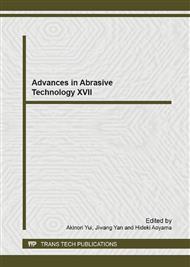p.21
p.27
p.33
p.38
p.44
p.50
p.55
p.61
p.66
A Controllable Material Removal Strategy Considering Force-Geometry Model in Marine Propeller Five-Axis Belt Grinding
Abstract:
Belt grinding is characterized by elastic contact grinding. Generally, the non-uniform material in complex machining area could be removed by repeated grinding or longer dwell-time grinding to obtain the required grinding capacity, which leads to low efficiency, difficult dimension accuracy control and poor surface quality. It should be considered thoroughly surface geometry, grinding force and system stiffness in surface belt grinding. Belt grinding parameters can be then dynamically adjusted. This paper focuses on controlling material removal efficiently and uniformly in marine propeller belt grinding. The material removal process is modelled considering elastic contact between grinding wheel and workpiece. Then, a grinding depth and grinding dwell time control strategy of surface belt grinding is proposed based on rigid-flexible coupled analysis. The variable feed grinding experiments were carried out on the developed five-axis CNC belt grinding machine integrated measuring and machining. The marine propeller with cast aluminum bronze (ZCuAl8Mn13Fe3Ni2) was employed to validate the proposed controllable material removal strategy. It is shown that the proposed strategy is feasible and efficient.
Info:
Periodical:
Pages:
44-49
Citation:
Online since:
September 2014
Authors:
Price:
Сopyright:
© 2014 Trans Tech Publications Ltd. All Rights Reserved
Share:
Citation:


